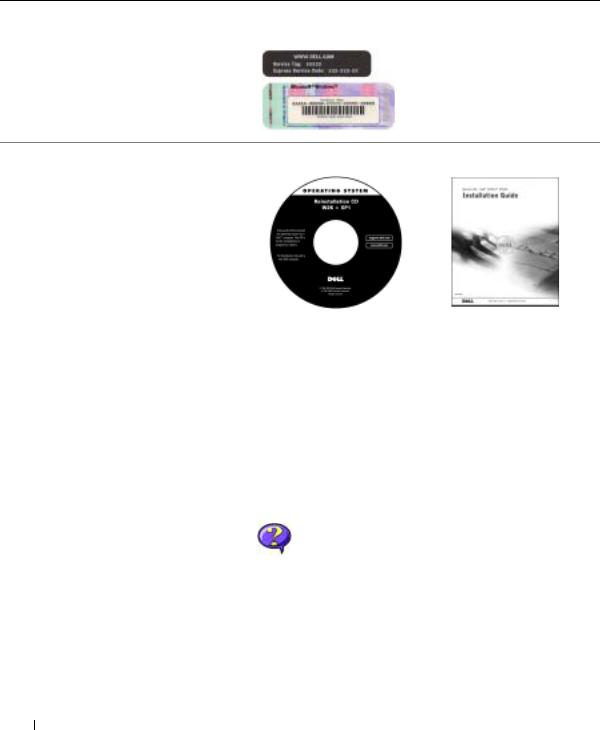Dell DHM User Manual

Dell™ OptiPlex™ Systems
Setup and Quick
Reference Guide
Models DHS, DHP, and DHM
w w w . d e l l . c o m | s u p p o r t . d e l l . c o m

Contents
About This Guide . . . . . . . . . . . . . . . . . . . . . . . . . . |
5 |
Finding Information for Your Computer . . . . . . . . . . . . . . |
5 |
CAUTION: Safety Instructions . . . . . . . . . . . . . . . . . . . |
8 |
General . . . . . . . . . . . . . . . . . . . . . . . . . . . . . |
8 |
When Using Your Computer . . . . . . . . . . . . . . . . . . . . |
10 |
When Working Inside Your Computer . . . . . . . . . . . . . . |
11 |
Getting Started/Setup . . . . . . . . . . . . . . . . . . . . . . . |
12 |
Monitor Connections . . . . . . . . . . . . . . . . . . . . . . . . |
16 |
Completed Setup . . . . . . . . . . . . . . . . . . . . . . . . . . |
18 |
Solving Problems . . . . . . . . . . . . . . . . . . . . . . . . . . |
18 |
Using the Drivers and Utilities CD . . . . . . . . . . . . . . . . |
19 |
Dell Diagnostics . . . . . . . . . . . . . . . . . . . . . . . . . . . |
20 |
When to Use the Dell Diagnostics . . . . . . . . . . . . . . . . |
20 |
Starting the Dell Diagnostics . . . . . . . . . . . . . . . . . . |
20 |
Running the Dell IDE Hard Drive Diagnostics . . . . . . . . . . |
22 |
Regulatory Information . . . . . . . . . . . . . . . . . . . . . . . |
22 |
Class A . . . . . . . . . . . . . . . . . . . . . . . . . . . . . |
23 |
Class B . . . . . . . . . . . . . . . . . . . . . . . . . . . . . |
23 |
NOM Information (Mexico Only) . . . . . . . . . . . . . . . . |
24 |
Limited Warranties and Return Policy . . . . . . . . . . . . . . . |
25 |
Limited Warranty for the U.S. . . . . . . . . . . . . . . . . . |
25 |
"Total Satisfaction" Return Policy (U.S. Only) . . . . . . . . . . |
28 |
Limited Warranty Terms for Canada . . . . . . . . . . . . . . |
29 |
"Total Satisfaction" Return Policy (Canada Only) . . . . . . . . . |
33 |
Contents 3

Dell Software and Peripherals (Canada Only) . . . . . . . . . . |
33 |
One-Year End-User Manufacturer Guarantee |
|
(Latin America and the Caribbean Only) . . . . . . . . . . . . |
34 |
Intel® Warranty Statement for Pentium® and |
|
Celeron® Processors Only (U.S. and Canada Only) . . . . . . . |
36 |
4 Contents

About This Guide
This document contains getting started/setup, solving problems, and safety, regulatory, and warranty information about your Dell™ OptiPlex™ computer.
To obtain the latest versions of the documents on your hard drive, see the Dell Support website at support.dell.com.
Regulatory model numbers appear throughout this document; their chassis type equivalents are shown below:
Regulatory Model Numbers and Chassis Types
DHS = small desktop (SD) chassis
DHP = small form-factor (SF) chassis
DHM = small mini-tower (SMT) chassis
Finding Information for Your Computer
What Are You Looking For? |
Find it Here |
|
|
• A diagnostic program for my computer |
D r i v e r s a n d U t i l i t i e s C D ( a l s o k n o w n a s t h e |
• Drivers for my computer |
R e s o u r c e C D ) |
• My computer documentation |
|
• My device documentation |
|
Documentation and drivers are already installed on your computer when shipped from Dell. You can use the CD to reinstall drivers, run the Dell Diagnostics, or access your documentation.
Readme files may be included on your CD to provide last-minute updates about technical changes to your computer or advanced technical-reference material for experienced users or technicians.
Setup and Quick Reference Guide |
5 |

w w w . d e l l . c o m | s u p p o r t . d e l l . c o m
What Are You Looking For? |
Find it Here |
|
|
• Express Service Code and Service Tag |
E x p r e s s S e r v i c e C o d e a n d P r o d u c t Ke y L a b e l |
• Microsoft® Windows® License Label |
These labels are located on your |
|
computer. |
• How to reinstall my operating system |
O p e r a t i n g S y s t e m C D a n d I n s t a l l a t i o n G u i d e |
|
After you reinstall your operating system using the Operating System |
|
Reinstallation CD, use the Drivers and Utilities CD to reinstall |
|
drivers for the devices that came with your computer. |
|
The product key for your operating system is located on your |
|
computer. |
|
|
• How to remove and replace parts |
U s e r ’ s G u i d e |
• How to obtain technical specifications |
W i n d o w s H e l p a n d S u p p o r t C e n t e r |
• How to configure system settings |
1 Click the Start button and click Help and Support. |
• How to troubleshoot and solve problems |
2 Click User’s and system guides and click User’s guides. |
|
M i c r o s o f t W i n d o w s 2 0 0 0 |
|
Double-click the User’s Guides icon on your desktop. |
6 Setup and Quick Reference Guide

What Are You Looking For? |
Find it Here |
|
|
|
|
• Latest drivers for my computer |
D e l l S u p p o r t We b s i t e — support.dell.com |
|
• Answers to technical service and support |
The Dell Support website provides several online tools, including: |
|
questions |
• Solutions — Troubleshooting hints and tips, articles from |
|
• Online discussions with other users and |
||
technicians, and online courses |
||
technical support |
• Community Forum — Online discussion with other Dell |
|
• Documentation for my computer |
||
customers |
||
|
• Upgrades — Upgrade information for components, such as |
|
|
memory, the hard drive, and the operating system |
|
|
• Customer Care — Contact information, order status, warranty, |
|
|
and repair information |
|
|
• Downloads — Drivers, patches, and software updates |
|
|
• Reference — Computer documentation, product specifications, |
|
|
and white papers |
|
|
|
|
• Service call status and support history |
D e l l P r e m i e r S u p p o r t We b s i t e — |
|
• Top technical issues for my computer |
premiersupport.dell.com |
|
• Frequently asked questions |
The Dell Premier Support website is customized for corporate, |
|
• File downloads |
government, and education customers. This website may not be |
|
• Details on my computer configuration |
available in all regions. |
|
|
||
• Service contract for my computer |
|
|
|
|
|
• How to use Windows XP |
W i n d o w s H e l p a n d S u p p o r t C e n t e r |
|
• Documentation for my computer |
1 Click the Start button and click Help and Support. |
|
• Documentation for devices (such as a |
2 Type a word or phrase that describes your problem and click the |
|
modem) |
arrow icon. |
|
|
3 Click the topic that describes your problem. |
|
|
4 Follow the instructions on the screen. |
|
|
|
Setup and Quick Reference Guide |
7 |

w w w . d e l l . c o m | s u p p o r t . d e l l . c o m
 CAUTION: Safety Instructions
CAUTION: Safety Instructions
Use the following safety guidelines to help ensure your own personal safety and to help protect your computer and working environment from potential damage.
General
•Do not attempt to service the computer yourself unless you are a trained service technician. Always follow installation instructions closely.
•To help prevent electric shock, plug the computer and device power cables into properly grounded electrical outlets. These cables are equipped with 3-prong plugs to help ensure proper grounding. Do not use adapter plugs or remove the grounding prong from a cable. If you must use an extension cable, use a 3-wire cable with properly grounded plugs.
•To help avoid the potential hazard of electric shock, do not use your computer during an electrical storm.
•To help avoid the potential hazard of electric shock, do not connect or disconnect any cables or perform maintenance or reconfiguration of this product during an electrical storm.
•If your computer includes a modem, the cable used with the modem should be manufactured with a minimum wire size of 26 American wire gauge (AWG) and an FCCcompliant RJ-11 modular plug.
•Before you clean your computer, disconnect the computer from the electrical outlet. Clean your computer with a soft cloth dampened with water. Do not use liquid or aerosol cleaners, which may contain flammable substances.
•To help avoid possible damage to the system board, wait 5 seconds after turning off the computer before disconnecting a device from the computer.
8 Setup and Quick Reference Guide
 CAUTION: Safety Instructions (continued)
CAUTION: Safety Instructions (continued)
•To avoid shorting out your computer when disconnecting a network cable, first unplug the cable from the network adapter on the back of your computer, and then from the network jack. When reconnecting a network cable to your computer, first plug the cable into the network jack, and then into the network adapter.
•To help protect your computer from sudden, transient increases and decreases in electrical power, use a surge suppressor, line conditioner, or uninterruptible power supply (UPS).
•Ensure that nothing rests on your computer’s cables and that the cables are not located where they can be stepped on or tripped over.
•Do not push any objects into the openings of your computer. Doing so can cause fire or electric shock by shorting out interior components.
•Keep your computer away from radiators and heat sources. Also, do not block cooling vents. Avoid placing loose papers underneath your computer; do not place your computer in a closed-in wall unit or on a bed, sofa, or rug.
•Do not spill food or liquids on your computer. If the computer gets wet, consult your
User’s Guide.
Setup and Quick Reference Guide |
9 |

w w w . d e l l . c o m | s u p p o r t . d e l l . c o m
When Using Your Computer
As you use your computer, observe the following safe-handling guidelines.
 CAUTION: Do not operate your computer with any cover(s) (including computer covers, bezels, filler brackets, front-panel inserts, and so on) removed.
CAUTION: Do not operate your computer with any cover(s) (including computer covers, bezels, filler brackets, front-panel inserts, and so on) removed.
•Your computer is equipped with one of the following:
–A fixed-voltage power supply — Computers with a fixed-voltage power supply do not have a voltage selection switch on the back panel and operate at only one voltage (see the regulatory label on the outside of the computer for its operating voltage).
–An auto-sensing voltage circuit — Computers with an auto-sensing voltage circuit do not have a voltage selection switch on the back panel and automatically detect the correct operating voltage.
–A manual voltage selection switch — Computers with a voltage selection switch on the back panel must be manually set to operate at the correct operating voltage.
NOTICE: To help avoid damaging a computer with a manual voltage selection switch, set the switch for the voltage that most closely matches the AC power available in your location. For Japan, the voltage selection switch must be set to the 115-V position even though the AC power available in Japan is 100 V. Also, ensure that your monitor and attached devices are electrically rated to operate with the AC power available in your location.
•Before working inside the computer, unplug the computer to help prevent electric shock or system board damage. Certain system board components continue to receive power any time the computer is connected to AC power.
10 Setup and Quick Reference Guide

When Using Your Computer (continued)
When Working Inside Your Computer
Before you open the computer cover, perform the following steps in the sequence indicated.
 CAUTION: Do not attempt to service the computer yourself, except as explained in your online Dell documentation or in instructions otherwise provided to you by Dell. Always follow installation and service instructions closely.
CAUTION: Do not attempt to service the computer yourself, except as explained in your online Dell documentation or in instructions otherwise provided to you by Dell. Always follow installation and service instructions closely.
NOTICE: To help avoid possible damage to the system board, wait 5 seconds after turning off the computer before removing a component from the system board or disconnecting a device from the computer.
1Perform an orderly computer shutdown using the operating system menu.
2Turn off your computer and any devices connected to the computer.
3Ground yourself by touching an unpainted metal surface on the chassis, such as the metal around the card-slot openings at the back of the computer, before touching anything inside your computer.
While you work, periodically touch an unpainted metal surface on the computer chassis to dissipate any static electricity that might harm internal components.
4Disconnect your computer and devices, including the monitor, from their electrical outlets. Also, disconnect any telephone or telecommunication lines from the computer.
Doing so reduces the potential for personal injury or shock.
In addition, take note of these safety guidelines when appropriate:
•When you disconnect a cable, pull on its connector or on its strain-relief loop, not on the cable itself. Some cables have a connector with locking tabs; if you are disconnecting this type of cable, press in on the locking tabs before disconnecting the cable. As you pull connectors apart, keep them evenly aligned to avoid bending any connector pins. Also, before you connect a cable, ensure that both connectors are correctly oriented and aligned.
•Handle components and cards with care. Do not touch the components or contacts on a card. Hold a card by its edges or by its metal mounting bracket. Hold a component such as a microprocessor chip by its edges, not by its pins.
 CAUTION: There is a danger of a new battery exploding if it is incorrectly installed. Replace the battery only with the same or equivalent type recommended by the manufacturer. Do not dispose of the battery along with household waste. Contact your local waste disposal agency for the address of the nearest battery deposit site.
CAUTION: There is a danger of a new battery exploding if it is incorrectly installed. Replace the battery only with the same or equivalent type recommended by the manufacturer. Do not dispose of the battery along with household waste. Contact your local waste disposal agency for the address of the nearest battery deposit site.
Setup and Quick Reference Guide |
11 |

w w w . d e l l . c o m | s u p p o r t . d e l l . c o m
Getting Started/Setup
 CAUTION: Before performing any of the procedures in this section, follow the safety instructions in the System Information Guide.
CAUTION: Before performing any of the procedures in this section, follow the safety instructions in the System Information Guide.
NOTICE: If your computer has an expansion card installed (such as a network card), connect the appropriate cable to the card, not to the connector on the computer back panel.
You must complete all steps to properly set up your computer. See the appropriate figures that follow the instructions.
1 Connect the keyboard and mouse.
NOTICE: Do not attempt to operate a PS/2 mouse and a USB mouse simultaneously.
NOTE: If you have a Universal Serial Bus (USB)-compliant mouse or keyboard, use the USB connectors on the back of your system.
2 Connect the modem or network cable.
Insert the network cable, not the phone line, into the network connector. If you have an optional modem, connect the phone line to the modem.
NOTICE: Do not connect a modem cable to the network adapter. Voltage from telephone communications can cause damage to the network adapter.
3 Connect the monitor.
Align and gently insert the monitor cable to avoid bending connector pins. Tighten the thumbscrews on the cable connectors.
NOTE: Some flat-panel displays and graphic cards support Digital Visual Interface (DVI). If your monitor and card have DVI connectors, Dell recommends that you use DVI instead of VGA.
NOTE: Some monitors have the video connector underneath the back of the screen. See the documentation that came with your monitor for its connector locations.
A second monitor is optional and requires a multimonitor graphics adapter card. To enable dual-monitor support, both monitors must be attached when the computer starts. See "Monitor Connections" on page 16 for more information on attaching two monitors.
4Connect the speakers.
5Connect power cables to the computer, monitor, and devices and insert the other ends of the power cables to electrical outlets.
12 Setup and Quick Reference Guide
